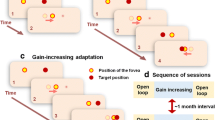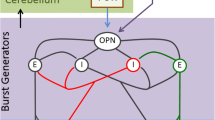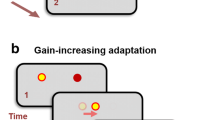Abstract
One of the clinical oculomotor hallmarks of lateral medullary infarction (Wallenberg's syndrome) is the so-called saccadic lateropulsion. In man and in animals, cerebellar lesions lead to dysmetric saccades and underline the importance of cerebellar control on saccadic accuracy. In order to study the lesion site responsible for saccadic lateropulsion we prospectively examined 12 patients with Wallenberg's syndrome who did not show a cerebellar lesion on CT or MRI. All patients consistently showed hypermetric saccades to the ipsilateral side and hypometric contralateral saccades comparable with the effects of cerebellar lesions in monkeys on saccadic accuracy. Based on the most recent experiments involving recordings from saccade-related neurons in the deep cerebellar nuclei of monkeys (oculomotor region of fastigial nucleus), we hypothesize that saccadic lateropulsion in lateral medullary infarction is essentially identical with cerebellar saccadic dysmetria and results from a disruption of afferent olivocerebellar climbing fibres that gives rise to functional disinhibition of the cerebellar cortex and to increased inhibition of the deep cerebellar nuclei.
Similar content being viewed by others
References
Amarenco P, Hauw JJ (1989) Anatomy of the cerebellar arteries. Rev Neurol (Paris) 145:267–276
Armstrong DM, Schild RF (1978) An investigation of cerebellar corticonuclear projections in the rat using an autoradiographic tracing method. I. Projections from the vermis. Brain Res 141:1–19
Aschoff JC, Cohen B (1970) Changes in saccadic eye movements produced by cerebellar cortical lesions. Exp Neurol 32:123–133
Balch RW, Yee RD, Honrubia V (1981) Eye movements in patients with Wallenberg's syndrome. Ann N Y Acad Sci 374:600–613
Benedetti F, Montarolo PG; Strata P, Tempia F (1983) Inferior olive inactivation decreases the excitability of the intracerebellar and lateral vestibular nuclei in the rat. J Physiol (Lond) 340:195–208
Bjerver K, Silfverskiöld BP (1968) Lateropulsion and imbalance in Wallenberg's syndrome. Acta Neurol Scand 44:91–100
Brazis PW (1992) Ocular motor abnormalities in Wallenberg's lateral medullary syndrome. Mayo Clin Proc 67:365–368
Bötzel K, Rottach K, Büttner U (1993) Normal and pathological saccadic dysmetria. Brain 116:337–353
Crevits L, Vander Eecken H (1982) Ocular lateropulsion in Wallenberg's syndrome: a prospective clinical study. Acta Neurol Scand 65:219–222
Demer LJ, Echelman DA, Robinson DA (1985) Effects of electrical stimulation and reversible lesions of the olivocerebellar pathway on Purkinje cell activity in the flocculus of the cat. Brain Res 346:22–31
Dieterich M, Brandt T (1992) Wallenberg's syndrome: lateropulsion, cyclorotation, and subjective visual vertical in thirty-six patients. Ann Neurol 31:399–408
Eccles JC, Linas R, Sasaki K (1966) The excitatory synaptic action of climbing fibres on the purkinje cells of the cerebellum. J Physiol (Loud) 182:268–292
Fisher CM, Karnes W, Kubick C (1961) Lateral medullary infarction: the pattern of vascular occlusions. J Neuropathol Exp Neurol 20:323–379
Hess BJM, Savio T, Strata P (1988) Dynamic characteristics of optokinetically controlled eye movements following inferior olive lesions in the brown rat. J Physiol (Lond) 397:349–370
Kase CS, Norrving B, Levine S, Babikian VL, Chodosh EH, Wolf PA, Welch KMA (1993) Cerebellar infarction. Clinical and anatomic observations in 66 cases. Stroke 24:76–83
Kommerell G, Hoyt WF (1973) Lateropulsion of saccadic eye movements. Arch Neurol 28:313–318
Litwak J, Mercuglino M, Chesselet MF, Oltmans GA (1990) Increased glutamic acid decarboxylase (GAD) mRNA and GAD activity in cerebellar Purkinje cells following lesion-induced increases in cell firing. Neurosci Lett 116:179–183
Meyer KT, Baloh RW, Krohel GB, Hepler RS (1980) Ocular lateropulsion. A sign of lateral medullary disease. Arch Ophthalmol 98:1614–1616
Nieuwenhuys R, Voogd J, Van Hujzen CH (1980) The human central nervous system. A synopsis and atlas. Springer, Heidelberg Berlin New York
Noda H, Fujikado T (1987) Involvement of purkinje cells in evoking saccadic eye movements by microstimulation of posterior cerebellar vermis of monkeys. J Neurophysiol 57:1247–1261
Noda H, Fujikado T (1987) Topography of the oculomotor area of the cerebellar vermis in macaques as determined by microstimulation. J Neurophysiol 58:359–378
Noda H, Sugita S, Ikeda Y (1990) Afferent and efferent connections of the oculomotor region of the fastigial nucleus in the macaque monkey. J Comp Neurol 302:330–348
Norrving B, Cronqvist S (1991) Lateral medullary infarction: prognosis in an unselected series. Neurology 41:244–248
Ohtsuka K, Noda H (1991) The effect of microstimulation of the oculomotor vermis on discharges of fastigial neurons and visually-directed saccades in macaques. Neurosci Res 10:290–295
Ohtsuka K, Noda H (1991) Saccadic burst neurons in the oculomotor region of the fastigial nucleus of macaque monkeys. J Neurophysiol 65:1422–1434
Optican LM, Robinson DA (1980) Cerebellar-dependent adaptive control of primate saccadic system. J Neurophysiol 44:1058–1076
Ritchie L (1976) Effects of cerebellar lesions on saccadic eye movements. J Neurophysiol 39:1246–1256
Robinson FR, Straube A, Fuchs AF (1993) Role of the caudal fastigial nucleus in saccade generation. II. Effects of Muscimol inactivation. J Neurophysiol 70:1741–1758
Sato H, Noda H (1992) Saccadic dysmetria induced by transient functional decortication of the cerebellar vermis. Exp Brain Res 88:455–458
Selhorst JB, Stark L, Ochs AL, Hoyt WF (1976) Disorders in cerebellar ocular motor control. I. Saccadic overshoot dysmetria. An oculographic, control system and clinico-anatomical analysis. Brain 99:497–508
Straube A, Kurzan R, Helmchen C, Büttner U (1992) Ist die Lateropulsion beim Wallenberg-Syndrom bedingt durch eine Funktionsstörung des Hirnstammes oder des Kleinhirnes? Akt Neurol 19:1k
Thach WT (1972) Cerebellar output properties, synthesis and uses. Brain Res 40:89–97
Waespe W, Baumgartner R (1992) Enduring dysmetria and impaired gain adaptivity of saccadic eye movements in Wallenberg's lateral medullary syndrome. Brain 115:1125–1146
Waespe W, Wichmann W (1990) Oculomotor disturbances during visualvestibular interaction in Wallenberg's lateral medullary syndrome. Brain 113:821–846
Yamada J, Noda H (1987) Afferent and efferent connections of the oculomotor cerebellar vermis in the macaque monkey. J Comp Neurol 265:224–241
Author information
Authors and Affiliations
Rights and permissions
About this article
Cite this article
Helmchen, C., Straube, A. & Büttner, U. Saccadic lateropulsion in Wallenberg's syndrome may be caused by a functional lesion of the fastigial nucleus. J Neurol 241, 421–426 (1994). https://doi.org/10.1007/BF00900959
Received:
Revised:
Accepted:
Issue Date:
DOI: https://doi.org/10.1007/BF00900959




